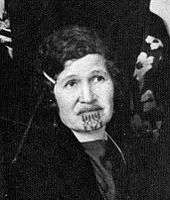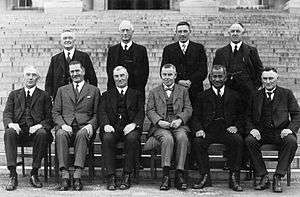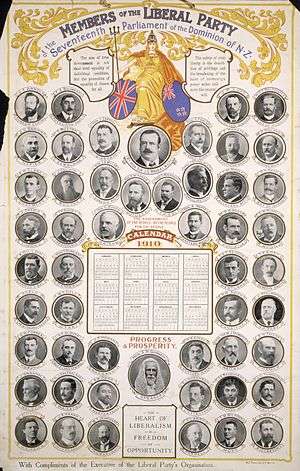Āpirana Ngata
| The Honourable Sir Āpirana Turupa Ngata | |
|---|---|
 Āpirana Ngata in 1934 | |
| 22nd Minister of Māori Affairs | |
|
In office 10 December 1928 – 1 November 1934 | |
| Monarch | George V |
| Prime Minister |
Sir Joseph Ward George Forbes |
| Preceded by | Gordon Coates |
| Succeeded by | George Forbes |
| Member of the New Zealand Parliament for Eastern Maori | |
|
In office 1905 – 1943 | |
| Preceded by | Wi Pere |
| Succeeded by | Tiaki Omana |
| Personal details | |
| Born |
3 July 1874 Te Araroa, Gisborne, New Zealand |
| Died |
14 July 1950 (aged 76) Waiomatatini, New Zealand |
| Political party |
Liberal United National |
| Spouse(s) | Arihia Kane Tamati (married 1895) |
Sir Āpirana Turupa Ngata (3 July 1874 – 14 July 1950) was a prominent New Zealand politician and lawyer. He has often been described as the foremost Māori politician to have ever served in Parliament, and is also known for his work in promoting and protecting Māori culture and language.
Early life
One of 15 children, Ngata was born in Te Araroa (then called Kawakawa), a small coastal town about 175 km (109 mi) north of Gisborne, New Zealand.[1] His iwi was Ngāti Porou. His father was Paratene Ngata, a tribal leader and expert in traditional lore, and his mother was Katerina Naki, the daughter of an itinerant Scot, Abel Knox.[2] Ngata was greatly influenced both by his father and by his great-uncle Ropata Wahawaha (who had led loyal kupapa Ngāti Porou forces against their Pai Mārire enemy (commonly known as Hauhau) in the East Cape War and later Te Kooti's escapees from the Chatham Islands.)[3] Ngata was raised in a Māori environment, speaking the Māori language, but his father also ensured that Ngata learned about the Pākehā world, believing that this understanding would be of benefit to Ngāti Porou.
Ngata attended primary school in Waiomatatini before moving on to Te Aute College, where he received a Pākehā-style education. Ngata performed well, and his academic results were enough to win him a scholarship to Canterbury University College (now the University of Canterbury), where he studied political science and law. He gained a BA in politics in 1893, the first Māori to complete a degree at a New Zealand university, then gained an LL.B. at the University of Auckland in 1896 (the first New Zealander, Māori or Pakeha, to gain a double degree).[4]
Marriage

In 1895, a year before finishing his second degree (law), Ngata married 16-year-old Arihia Kane Tamati who was also of the Ngāti Porou iwi. Ngata had previously been engaged to Arihia's elder sister, Te Rina, but she died. Āpirana and Arihia had eleven children; six girls and five boys.[1]
Shortly after Ngata's legal qualifications were recognised, he and his wife returned to Waiomatatini where they built a house. Ngata quickly became prominent in the community, making a number of efforts to improve the social and economic conditions of Māori across the country. He also wrote extensively on the place of Māori culture in the modern age. At the same time, he gradually acquired a leadership role within Ngāti Porou, particularly in the area of land management and finance.
Political career
Ngata's first involvement with national politics came through his friendship with James Carroll, who was Minister of Native Affairs in the Liberal Party government. Ngata assisted Carroll in the preparation of two pieces of legislation, both of which were intended to increase the legal rights enjoyed by Māori. In the 1905 election, Ngata himself stood as the Liberal candidate for the Eastern Maori electorate, challenging the incumbent Wi Pere. He was elected to Parliament.
Early career
| Parliament of New Zealand | ||||
| Years | Term | Electorate | Party | |
| 1905–1908 | 16th | Eastern Maori | Liberal | |
| 1908–1911 | 17th | Eastern Maori | Liberal | |
| 1911–1914 | 18th | Eastern Maori | Liberal | |
| 1914–1919 | 19th | Eastern Maori | Liberal | |
| 1919–1922 | 20th | Eastern Maori | Liberal | |
| 1922–1925 | 21st | Eastern Maori | Liberal | |
| 1925–1928 | 22nd | Eastern Maori | Liberal | |
| 1928 | Changed allegiance to: | United | ||
| 1928–1931 | 23rd | Eastern Maori | United | |
| 1931–1935 | 24th | Eastern Maori | United | |
| 1935–1936 | 25th | Eastern Maori | United | |
| 1936–1938 | Changed allegiance to: | National | ||
| 1938–1943 | 26th | Eastern Maori | National | |

Ngata quickly distinguished himself in Parliament as a skilled orator. He worked closely with his friend Carroll, and also worked closely with Robert Stout. Ngata and Stout, members of the Native Land Commission, were often critical of the government's policies towards Māori, particularly those designed at encouraging the sale of Māori land. In 1909, Ngata assisted John Salmond in the drafting of the Native Land Act.
In late 1909, Ngata was appointed to Cabinet, holding a minor ministerial responsibility for Māori land councils. He retained this position until 1912, when the Liberal government was defeated. Ngata followed the Liberals into Opposition.
In the First World War, Ngata was highly active in gathering Māori recruits for military service, working closely with Reform Party MP Maui Pomare. Ngata's own Ngāti Porou were particularly well represented among the volunteers. The Māori commitment to the war by some iwi, which became a mainly Cook Island commitment after 1942, can be attributed to Ngata and Pomare, created a certain amount of goodwill from Pākehā towards iwi who had loyally supported the country, and assisted Ngata's later attempts to resolve land grievances.
Although in Opposition, Ngata enjoyed relatively good relations with his counterparts across the House in the Reform Party. He had a particularly good relationship with Gordon Coates, who became Prime Minister in 1925 and later "princess" Te Puea of Waikato. The establishment of several government bodies, such as the Māori Purposes Fund Control Board and the Board of Māori Ethnological Research, owed much to Ngata's involvement.
Māori interests

Ngata was also active in a huge variety of other endeavours. The most notable, perhaps, was his involvement in academic and literary circles – in this period, he published a number of works on significant Māori culture, with Nga moteatea, a collection of Māori songs, being one of his better known works. Ngata was also heavily involved in the protection and advancement of Māori culture among Māori themselves, giving particular attention to promoting the haka, poi dancing, and traditional carving that had been begun by Te Puea. One aspect of his advocacy of Māori culture was the construction of many new traditional meeting houses throughout the country. Yet another of Ngata's interests was the promotion of Māori sport, which he fostered by encouraging intertribal competitions and tournaments. Finally, Ngata also promoted Māori issues within the Anglican Church in New Zealand, encouraging the creation of a Māori bishopric. In December 1928, Frederick Bennett, was consecrated as suffragan bishop to the Waiapu diocese with the title Bishop of Aotearoa.[5] Ngata and Bishop Herbert Williams campaigned for the recognition of Māori language as a subject for study in the University of New Zealand, with the study of Māori becoming eligible for a degree of bachelor of arts in 1928.[5]
Throughout all this, Ngata also remained deeply involved in the affairs of his Ngāti Porou iwi, particularly as regards land development. He was instrumental in establishing the land incorporation scheme whereby unused Māori land with multiple owners were amalgamated under a farm manager—often Pākehā, who developed and ran the farm. In government he was able to arrange for the transfer of four blocks of farm land to Te Puea Herangi and her husband. He arranged grants and government loans to help her develop farms for Waikato. He fired the Pākehā farm manager and replaced him with Te Puea. He arranged a car for her so she could travel around her estates. In 1934, during the depression, the public, media and parliament became alarmed at the large sums of money being gifted to Te Puea and others. A royal commission was held and Ngata was found guilty of irregularities in expenditure and negligence in administration, but no major scandals were unearthed. His land projects up to 1934 had involved the expenditure of ₤500,000, most of which was recoverable. Ngata resigned in December 1934.[6] Ngata fought for higher living standards for the Māori people, and was very active during an economic depression in New Zealand in the Thirties, developing large farms which provided jobs and helped to restore the dignity of many Māori.[7]
Ngata was knighted in 1927,[8] only the third Māori (after Carroll and Pomare) to receive this honour.
Ministerial career

In the 1928 elections, the United Party (a rebranding of the old Liberal Party, to which Ngata belonged) won an unexpected victory. Ngata was returned to Cabinet, becoming Minister of Native Affairs. He was ranked third within Cabinet, and occasionally served as acting Deputy Prime Minister. Ngata remained extremely diligent in his work, and was noted for his tirelessness. Much of his ministerial work related to land reforms, and the encouragement of Māori land development. Ngata continued to believe in the need to rejuvenate Māori society, and worked strongly towards this goal. In 1929, both Ngata's wife and eldest son died of illness.
In 1932 Ngata and his Department of Native Affairs came under increasing criticism from other politicians. Many believed that Ngata was pressing ahead too fast, and the large amount of activity that Ngata ordered had caused organizational difficulties within the department. An inquiry into Ngata's department was held, and it was discovered that one of Ngata's subordinates had falsified accounts. Ngata himself was severely criticised for disregarding official regulations which he had often felt were inhibiting progress. It was also alleged that Ngata had shown favouritism to Ngāti Porou and Waikato, especially Te Puea and her husband. Robert Semple, the labour leader, said the investigation (by the royal commission) showed one of the worst specimens of abuse of political power, maladministration, misappropriation of public funds as well as a betrayal of trust. Ngata, while denying any personal wrongdoing, accepted responsibility for the actions of his department and was dismissed from his ministerial position.
Māori leaders, such as Te Puea, were angry at Ngata for discrediting and embarrassing Māori.[9]

Later life and legacy
Although Ngata had resigned from Cabinet, he still remained in Parliament. He was awarded the King George V Silver Jubilee Medal in 1935.[10] In the 1935 elections, the Labour Party was triumphant – Ngata went into Opposition, although the new Labour government retained many of his land reform programs. Ngata remained in Parliament until the 1943 elections, when he was finally defeated by a Labour-Ratana candidate, Tiaki Omana. He stood again for his seat in the 1946 elections, but was unsuccessful.
Despite leaving Parliament, Ngata remained involved in politics. He gave advice on Māori affairs to both Peter Fraser (a Labour Prime Minister) and Ernest Corbett (a National Minister of Māori Affairs), and arranged celebrations of the Treaty of Waitangi's centenary in 1940. In the Second World War, he once again helped gather Māori recruits. On 22 June 1950, he was appointed to Parliament's upper house, the Legislative Council, but was too ill by this time to take his seat.[11]
Sir Āpirana and Lady Ngata guided the design of the St. Michael and All Angels’ Chapel at Hukarere Girls College, which chapel was consecrated on 1 November 1953.[12]
Ngata died in Waiomatatini on 14 July 1950. He is remembered for his great contributions to Māori culture and language. His image appears on New Zealand's $50 note.
Several schools have houses named after him, including Rangiora High School, Tauranga Boys' College, Rotorua Intermediate, Cashmere High School, Te Aute College (where Ngata went), Te Puke High School and Otumoetai Intermediate.
Family
On 19 October 2009, Āpirana Ngata's last surviving daughter, Mate Huatahi Kaiwai (born Ngata), died at her residence at Ruatoria, East Cape, New Zealand, aged 94. She was interred next to her late husband Kaura-Ki-Te-Pakanga Kaiwai and her son Tanara Kaiwai at Pukearoha Urupa.
Āpirana Ngata's youngest son, Sir Henare Ngata (born 1918), died on 11 December 2011. He was Māori vice-president of the party 1967-69 and stood as the National Party candidate for Eastern Māori in 1969. [13] [14]
Ngata's grandson Hōri Mahue Ngata wrote a widely used Māori-English dictionary.
Notes
- 1 2 A. H. McLintock, ed. (22 April 2009) [1966]. "Ngata, Sir Apirana Turupa". An Encyclopaedia of New Zealand. Ministry for Culture and Heritage / Te Manatū Taonga. Retrieved 8 December 2010.
- ↑ Sorrenson, M.P.K. "Ngata, Apirana Turupa". Dictionary of New Zealand Biography. Ministry for Culture and Heritage. Retrieved 15 October 2014.
- ↑ Redemption Songs.R. Binney. pp 195-203.
- ↑ Cyclopedia Company Limited (1908). "Mr. Apirana Turupa Ngata". The Cyclopedia of New Zealand : Taranaki, Hawke’s Bay & Wellington Provincial Districts. Christchurch. p. 301. Retrieved 10 December 2010.
- 1 2 Biggs, Bruce (30 October 2010). "Williams, Herbert William". Dictionary of New Zealand Biography. Te Ara – the Encyclopedia of New Zealand. Retrieved 22 September 2013.
- ↑ King, Michael (1977). Te Puea: A Biography. Auckland: Hodder and Stoughton. pp. 156–157. ISBN 0-340-22482-7.
- ↑ The Dorling Kindersley History Of The World, Plantagenet Somerset Fry, 1994
- ↑ The London Gazette: (Supplement) no. 33295. p. 4643. 19 July 1927. Retrieved 17 November 2013.
- ↑ Te Puea. M. King. Reed .2003,P 160-169.
- ↑ "Official jubilee medals". The Evening Post. CXIX (105). 6 May 1935. p. 4. Retrieved 16 November 2013.
- ↑ Wilson 1985, p. 160.
- ↑ "High-Perched Hukarere: a chapel made by many hands". No 3, Te Ao hou p. 32-35 & 53. 1953. Retrieved 28 December 2013.
- ↑ Te Puni, Alice (12 December 2011). "We lose Sir Henare". The Gisborne Herald. Retrieved 21 December 2011.
- ↑ Gustafson, Barry (1986). The First 50 Years : A History of the New Zealand National Party. Auckland: Reed Methuen. p. 380. ISBN 0-474-00177-6.
References
- Wilson, James Oakley (1985) [First ed. published 1913]. New Zealand Parliamentary Record, 1840–1984 (4th ed.). Wellington: V.R. Ward, Govt. Printer. OCLC 154283103.
External links
| Wikiquote has quotations related to: Āpirana Ngata |
| Wikimedia Commons has media related to Apirana Ngata. |
| New Zealand Parliament | ||
|---|---|---|
| Preceded by Wi Pere |
Member of Parliament for Eastern Maori 1905–1943 |
Succeeded by Tiaki Omana |